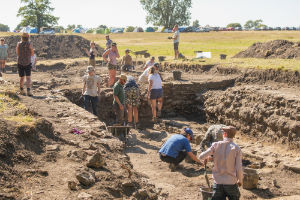See history being unearthed at Roman Silchester as baths excavation seeks answers to big questions
10 July 2018

Archaeologists at one of Britain’s earliest Roman buildings are digging deeper than ever before to investigate unanswered questions about the building.
Students and staff from the University of Reading have returned to Roman Silchester, in Hampshire, for this year’s Archaeology Field School to explore never-before-excavated areas of the baths, which date back around 2,000 years.
They are seeking to shed light on unanswered questions, such as when the baths were built and fell out of use, where their water supply came from and what Romans snacked on as they bathed.
Members of the public are now being invited to see the history of the baths being revealed, live before their eyes, at an open day at the site on Saturday 14 July.
Professor Mike Fulford, Director of the Silchester Archaeology Field School, said: “These baths have not been investigated in more than 100 years, so we are re-excavating them armed with a wealth of new knowledge and techniques that are already allowing us to make new findings.
“Fundamental questions remain about the building, and the lives of the Roman people who used them, but by digging in unexplored areas of the site we hope to take a leap forward in our understanding of this landmark of Roman Silchester and Roman Britain.”
"Fundamental questions remain about the building, and the lives of the Roman people who used them" - Professor Mike Fulford, University of Reading
The baths were first excavated in 1903-4 as part of the Society of Antiquaries' 20-year Silchester project (1890-1909). However, this resulted in little more than the creation of a site plan and some tentative ideas of changes made to the baths during their lifetime.
The Field School team is first seeking to check the accuracy of these antiquarian findings. Unearthing the building’s one-metre-high walls has revealed imported stones and local flint were used in their construction. To the south of the site, the remains of the large warm room are now visible, as well as the heating system which would have circulated hot air under the floor.
They believe the baths are very early, possibly built in the mid-1st century AD, and that major alterations, a consequence of raising the levels by bringing in huge quantities of gravel, were made around the turn of the 2nd century, most likely to combat flooding issues.
They have also gained insights into the water supply, which may have been tapped from nearby springs. Exploration of the communal toilets has revealed the original walls and a brick arch of a drain which took waste away.
Finally, modern archaeological science is allowing the team the chance to make major discoveries about life in the baths beyond simply bathing, and how this changed over time. Philosophers in Ancient Rome paint a picture of a lively environment where games were played and oil massages and hair removal services, as well as a variety of refreshments, were offered to bath-goers. The team wants to find out if this was also true of Silchester and how behaviour changed over time.
From the remains of animals, fish and plants, as well as from containers like imported wine amphoras, the team hopes to find out more about what food and drink was consumed at the baths and from equipment like strigils (for scraping off the oil) and glass containers about the use of oils and perfumes there.
The search for evidence continues until 21 July, and, funding permitting, for a further three summers, to answer these questions and others, such as a potential connection with Emperor Nero’s project for the town, whether the baths were in continuous use until the 5th century, and when they were robbed of their materials and reduced to foundations.
Open day
An open day will be held on Saturday 14 July, from 10am-4pm. Visitors can get tours of the excavations throughout the day by the project directors, Professor Mike Fulford and Amanda Clarke, along with displays and talks about the finds.
A dig pit will give children a chance to try archaeology for themselves. Refreshments will be available, including tea, cake and cold drinks, from St Mary’s Church adjacent to the dig.
Members of the public are also welcome to visit the Field School any other day up to and including Saturday 21 Julyfrom 10am-4pm, except for Friday 13 July. The excavations will be closed from Sunday 22 July.
About the Archaeology Field School
Archaeology students at the University of Reading have several opportunities to get involved in real excavations, in the Roman town of Silchester, Hampshire, and at the medieval Dunyvaig Castle on the island of Islay, Scotland. They are introduced to techniques such as cleaning, excavating and recording findings, as well as surveying, environmental sampling and processing artefacts.
Previous excavations in the Vale of Pewsey in Wiltshire, near to Stonehenge, have explored buildings and monuments dating back thousands of years, such as an ancient long barrow site which had been thought to contain human remains.
A free online course run by the University of Reading via FutureLearn also allows members of the public the chance to participate in a virtual field school. The two-week course looks at the Vale of Pewsey and how to reconstruct life from skeletal remains.
